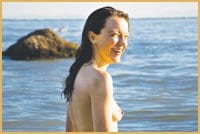It’s not difficult to imagine Carellin Brooks on trial, having been accused of witchcraft.
Such a scene would take place once upon a time, of course, a few centuries ago when the word “enthusiastic” was used as a code word to describe someone with a suspiciously non-puritanical excess of spirit (and likely, therefore, to be possessed by Satan).
With her manifold interests Brooks practically radiates enthusiasm. That’s true in conversation, too.
One of Vancouver’s perennially visible literary lesbians —a woman who knew she wanted to be a professional writer when she was six years old and held a regular newspaper column in her teens —Brooks currently deploys her writer’s talents across a range of practices.
In addition to her numerous as-yet-unpublished books of fiction, poetry, and memoirs, her publications reflect her native eclecticism. Her first publication, Bad Jobs (1998), was a tart and witty non-fiction collection in which authors recalled outstandingly awful employment experiences. Brooks then co-edited (with me) Carnal Nation (2000), a sex-themed fiction anthology featuring upcoming Canadian writers. Next up —and the culmination of her studies at Oxford as a Rhodes scholar —was Every Inch a Woman: Phallic Possession, Femininity, and the Text (2006), a scholarly tome with a probable readership of feminist professors and sexology historians.
Steering way clear of academic analysis, her latest publication, Wreck Beach (#16 in the Transmontanus series of Vancouver’s New Star Books), can be used as a travel guide that tells readers how to get there, what to seek out, and what to avoid.
Or, like the others of the series, it can be read as a sustained meditation on a remarkable BC place. Brooks calls it a “cultural geography.”
Though brief, the guide is layered with useful information for visitors; lively history (from its naming to the challenges Wreck faces from its very popularity and proximity to development-hungry UBC); peppery anecdotes (ranging from a foiled porn film shoot and a brief cocaine epidemic in the ’80s to its murders and anti-nudism protests); and observations about the beach community’s tacit rules and regulations (eg “Keep in mind that the one thing the Wreck Beach crowd most hates and fears is any hint of pedophilia”).
As the book’s lesbian beachgoer author, Brooks is also quick to note the scarcity of visibly lesbian enclaves on the sand.
Throughout, Brooks’ sharp observations ensure a pleasurable and informative reading experience for incoming tourists and habitués alike.
So does her vivid portraiture. Consider, for example, her survey of humanity sprawled over the sand: “A truly shocking variety of body shapes and sizes, from the morbidly obese to the frighteningly stringy and everything in between. Every shade of skin from fish belly to ebony”.
For Brooks, the enduring allure of Wreck Beach relates directly to its mystique. Though she’s been to other nude beaches, from Budapest to small town Florida, she has seen no other place with the same vibe.
It’s “the genius of the place” that she’s still trying to figure out: “There’s a confluence of stuff —people, landscape, history —that gives it that quality. But sometimes when you’re there, everything makes sense. And you get a feeling there, one I associate with the freedom of having sex where and with whom I want, or like riding topless on my bike. It feels mystical, in that vague, white sort of way.
“And to a degree, it’s a place where rules are suspended, and it shows us all that nothing bad necessarily happens when we decide to organize differently, socially. As North Americans become more boxed and more packaged into ready-made —people have begun to forget what exists outside that box. Wreck is a good reminder.
“At one level, then, this book is documentary by nature because Wreck’s uniqueness is always endangered.”
In addition to exploring the spiritual heart of the place, a chaperoned visit to the southern male territory of Wreck led Brooks to ponder the two distinct approaches to being unclothed.
As she sees it, the big difference between the two beaches is “the gay guys have the right idea.”
At the main beach, folks (and the long-term political organizers there in particular) try to deny or suppress the sensual and directly sexual aspect of nudism, she explains. At the men’s beach, the connection is taken as a given.
“Of course it’s erotic to see naked people. It seems odd or perverse to pretend otherwise.”
The book now written and released, Brooks is restless to begin anew —though cognizant that it’s a writer’s usual lot to face rejection and to work for a pittance.
After she refers to Evelyn Lau’s belief that a writer’s duty is to “talk about what is disturbing and expose what is uncomfortable,” we can guess that Brooks’ works-in-progress —a satiric novel (“with lots of perversion”) and prose poems about rain and relationship breakups (“God, who’ll want to read that?”) —will dwell dutifully and artfully on those very things that are dark and distressing in our world.

 Why you can trust Xtra
Why you can trust Xtra


